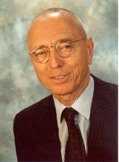Adrianus de Hoop
This article has multiple issues. Please help improve it or discuss these issues on the talk page. (Learn how and when to remove these template messages)
|
Adrianus T. de Hoop | |
|---|---|
 | |
| Born | 24 December 1927 Rotterdam, Netherlands |
| Alma mater | Delft University of Technology |
| Known for | Electromagnetic theory |
| Awards | IEEE Heinrich Hertz Medal (2001) |
| Scientific career | |
| Fields | Electrical engineering |
| Institutions | Delft University of Technology |
Adrianus Teunis (Aad) de Hoop (born 24 December 1927) is a Dutch electrical engineer. De Hoop was born in Rotterdam, the Netherlands. He received his MSc degree in electrical engineering (1950) and his PhD degree in the technological sciences (1958) from Delft University of Technology, Delft, the Netherlands, both with the highest distinction (cum laude). He served Delft University of Technology as an assistant professor (1950–1957), associate professor (1957–1960) and full professor in electromagnetic theory and applied mathematics (1960–1996). Since 1996, he is Lorentz Chair Emeritus Professor[1] in the Faculty of Electrical Engineering, Mathematics Computer Science of this university. In 1970, he founded at Delft the Laboratory of Electromagnetic Research, which has developed into a world-class center for electro-magnetics, having a huge impact on the world's electromagnetic community and on electromagnetic research and education in the Netherlands.
De Hoop's research interests are in the broad area of wavefield modeling in acoustics, electromagnetics and elastodynamics. His interdisciplinary insights and methods in this field can be found in his seminal Handbook of Radiation and Scattering of Waves (1995), with wavefield reciprocity serving as one of the unifying principles governing direct and inverse scattering problems and wave propagation in complex (anisotropic and dispersive) media. He spent a year (1956–1957) as a research assistant with the Institute of Geophysics, University of California at Los Angeles, CA, USA, where he pioneered a modification of the Cagniard technique for calculating impulsive wave propagation in layered media, later to be known as the Cagniard–de Hoop method. This technique is considered as a benchmark tool in analyzing time-domain wave propagation. During a sabbatical leave at Philips Natuurkundig Laboratorium, Eindhoven, the Netherlands (1976–1977), he was involved in research on magnetic recording theory.
Since 1982, De Hoop is on a regular basis Visiting Scientist with Schlumberger-Doll Research, formerly at Ridgefield, CT, now at Cambridge, MA, USA, where he contributes to research on geophysical applications of acoustic, electromagnetic and elastodynamic waves. Grants from the "Stichting Fund for Science, Technology and Research" (founded by Schlumberger) supported his research at Delft University of Technology. He was awarded the 1989 Research Medal of the Royal Institute of Engineers (KIVI) in the Netherlands, the IEEE 2001 Heinrich Hertz Medal[2] and the 2002 URSI (International Scientific Radio Union) Balthasar van der Pol Gold Research Medal. In 2003, Beatrix, Queen of the Netherlands appointed him Knight in the Order of the Netherlands Lion.
De Hoop is a Member of the Royal Netherlands Academy of Arts and Sciences since 1989[3] and a Foreign Member of the Royal Flemish Academy of Belgium for Science and the Arts. He holds an Honorary Doctorate (1981) in the Applied Sciences from Ghent University, Belgium and an honorary doctorate (2008) in the Mathematical, Physical and Engineering Sciences from Växjö University (since 2010, Linnaeus University), Växjö, Sweden.
He is exploring a method for computing pulsed electromagnetic fields in strongly heterogeneous media with application to (micro- or nano-scale) integrated circuits and a methodology for time-domain pulsed-field antenna analysis, design and optimization for mobile communication and radar applications.
His avocation is playing the piano and performing choral music with the Rotterdam Philharmonic Choir.
References
- ^ "Krasse Knarren" (in Dutch). Delft University of Technology - Delta. 4 November 2013. Archived from the original on 26 May 2020.
- ^ "IEEE Heinrich Hertz Medal Recipients" (PDF). Institute of Electrical and Electronics Engineers. Archived from the original (PDF) on 26 December 2019.
- ^ "Adrianus de Hoop". Royal Netherlands Academy of Arts and Sciences. Archived from the original on 11 May 2020.
External links
- 1927 births
- Living people
- Delft University of Technology alumni
- Delft University of Technology faculty
- Dutch electrical engineers
- Engineers from Rotterdam
- Knights of the Order of the Netherlands Lion
- Members of the Royal Flemish Academy of Belgium for Science and the Arts
- Members of the Royal Netherlands Academy of Arts and Sciences
- Microwave engineers
- Electrical engineering academics
